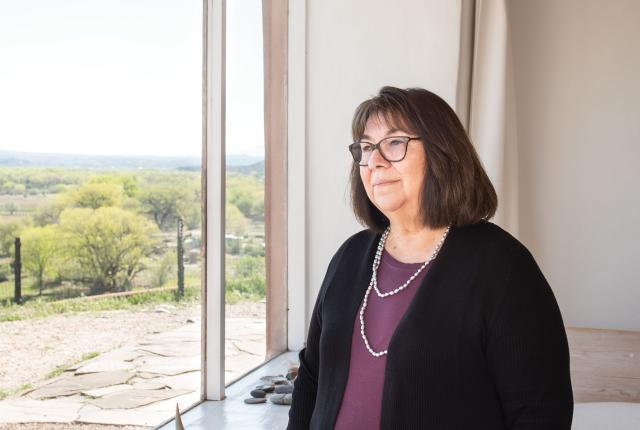Agapita Judy Lopez began working in Georgia O’Keeffe’s Abiquiú home in 1974. Photograph by Stefan Wachs.
RAISED IN ABIQUIÚ and between Barranco and Vallecitos, Agapita “Pita” Lopez grew up learning to garden from her maternal grandmother, her namesake, and to mud-plaster adobe facades from her paternal grandmother, Francesquita. After attending the College of Santa Fe for bookkeeping, Lopez began working in Georgia O’Keeffe’s Abiquiú home in 1974. By then suffering from macular degeneration, which affected her central vision, O’Keeffe hired Lopez as her official secretary, and then as a companion to help her get around the house without tripping over her beloved chow chow dogs. Lopez also accompanied the artist to major retrospectives across the country. After the artist’s death, in 1986, Lopez worked for O’Keeffe’s estate and then the Georgia O’Keeffe Foundation. She is now the Georgia O’Keeffe Museum’s director of historic properties. Lopez still reverently refers to the artist as Ms. O’Keeffe.
My family goes back four or more generations in the area. But like a lot of people in the thirties and forties, my parents moved to California to look for jobs. I was born in Sacramento while they worked at the Campbell Soup Company factory. Then they moved back and raised me in Abiquiú. My father was a laborer, and my mother worked at Ghost Ranch.
You’re related to everyone in Abiquiú. What can I say? You grew up calling everyone tía or tío, even if they weren’t related. They just had to be older than you. The Church of Santo Tomás burned down in Abiquiú.
The church of Santo Tomás burned down in Abiquiú. The new church of St. Thomas the Apostle is a John Gaw Meem design. The community wanted the entrance to face south, he wanted it to face east, and so they switched it around their way. He never wanted to claim it as his design as a result.
My grandmother Francesquita loved to cook, and she also mud-plastered—she was an enjarradora. She came to do mud plastering at Ms. O’Keeffe’s. The exterior of her Abiquiú home was adobe, and she would hire people to come after the winter months or when it rained. Before my grandfather Estiben Suazo worked here in the 1950s, she worked here.
I spent 12 years working with Ms. O’Keeffe. I began in late 1974, the first Christmas that I wasn’t at home. It was just across town. As her companion, I read to her, cooked, and took walks before breakfast, because she was an early riser. I did her correspondence and fed the dogs. She liked multitaskers.
Ms. O’Keeffe had three magazine subscriptions: New Mexico Magazine, National Geographic, and Prevention.
When I was a kid, Abiquiú had a Catholic school that was run by Dominican nuns. Four classrooms, two grades in each. There was also a public school up on the hill. I was already working with Ms. O’Keeffe when community members came to her for seed money to build a new school. Her only condition was that the new building blend with the landscape—that it be adobe-colored.
They asked if they could rename it Georgia O’Keeffe Elementary. She said no. She preferred to stay in the background, but she was generous with the community.
You knew who she was, but you didn’t come over. People knew she liked her privacy. Sometimes they called her a recluse. But she was always entertaining. She hired a lot of folks from the community. And those who worked with her became family. She would attend weddings, baptisms, and funerals.
Ms. O’Keeffe put farolitos along the wall during Christmas. Then she would leave a bottle of whiskey for Los Días—a time when older men would go through the village and “pedir al año nuevo” [ask for the new year], going to houses to serenade. People who were already asleep would leave a bottle of whiskey.
I’ve been in Río Arriba County all my life. The traditions—it’s still fantastic to have those in the modern era. The beauty of this place has never really gone away. I hope it never does.

SEE FOR YOURSELF
The Georgia O’Keeffe Museum offers tours of the artist’s home and studio in Abiquiú from March to November.


